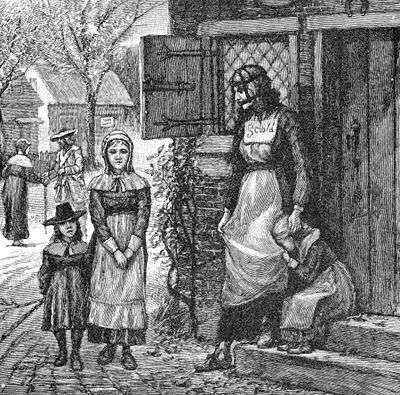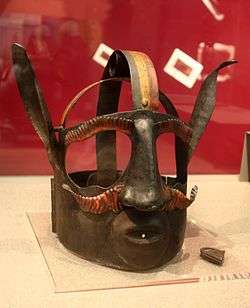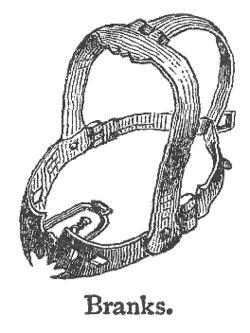Scold's bridle
A scold's bridle, sometimes called a witch's bridle, a brank's bridle, or simply branks,[1] was an instrument of punishment, as a form of torture and public humiliation.[2] The device was an iron muzzle in an iron framework that enclosed the head (although some bridles were masks that depicted suffering). A bridle-bit (or curb-plate), about 2 in × 1 in (5.1 cm × 2.5 cm) in size, was slid into the mouth and either pressed down on top of the tongue as a compress or used to raise the tongue to lie flat on the wearer's palate. This prevented speaking and resulted in many unpleasant side effects for the wearer, including excessive salivation and fatigue in the mouth.[3]



%2C_Abbot_House_Dunfermline.jpg)
Origin and purpose
England and Scotland
First recorded in Scotland in 1567, the branks were also used in England and its colonies. The kirk-sessions and barony courts in Scotland inflicted the contraption mostly on female transgressors and women considered to be rude, nags or common scolds.[4][5]
Branking (in Scotland and the North of England)[6][7][8][9] was designed as a mirror punishment for shrews or scolds; women of the lower classes whose speech was deemed "riotous" or "troublesome";[10] — often women suspected of witchcraft — by preventing such "gossips or scolds" from speaking. This also gives it its other name, 'The Gossip's Bridle'.
It was also used as corporal punishment for other offences, notably on female workhouse inmates. The person to be punished was placed in a public place for additional humiliation and sometimes beaten.[11] The Lanark Burgh Records record a typical example of the punishment being used: " Iff evir the said Elizabeth salbe fund [shall be found] scolding or railling… scho salbe sett [she shall sit] upone the trone in the brankis and be banishit [banished of] the toun thaireftir [thereafter]" (1653 Lanark B. Rec. 151).
Though primarily used on women, the Burgh Records of Scotland's major towns reveal that the branks were at times used on men as well: "Patrick Pratt sall sit … bound to the croce [cross] of this burgh, in the brankis lockit [branks lockèd]" (1591 Aberd. B Rec. II. 71) / "He shall be put in the branks be the space of xxiiij houres thairafter" (1559 (c 1650) Dundee B. Laws 19. )
When the branks was placed on the "gossiper's" head, they could be led through town to show that they had committed an offence or scolded too often. This was intended to humiliate them into "repenting" their "riotous" actions. A spike inside the gag prevented any talking since any movement of the mouth could cause a severe piercing of the tongue.[6] When wearing the device, it was impossible for the person either to eat or speak.[12] Other branks included an adjustable gag with a sharp edge, causing any movement of the mouth to result in laceration of the tongue.
In Scotland, branks could also be permanently displayed in public by attaching them, for example, to the town cross, tron or tolbooth. Then, the ritual humiliation would take place, with the miscreant on public show. Displaying the branks in public was intended to remind the populace of the consequences of any rash action or slander. Whether the person was paraded or simply taken to the point of punishment, the process of humiliation and expected repentance was the same. Time spent in the bridle was normally allocated by the kirk session, in Scotland, or a local magistrate.[12]
Quaker women were sometimes punished with the branks for preaching their doctrine in public places.[13]
Jougs were similar in their purpose as a pillory, but did not restrain the sufferer from speaking. They were generally used in both England and Scotland in the 16th and 17th centuries.[6]
The New World
The scold's bridle did not see much use in the New World, though Olaudah Equiano recorded that it was commonly used to control Virginia slaves in the mid-18th century.
Historical examples
- Scotland
In 1567, Bessie Tailiefeir (pron. Telfer) slandered Baillie Thomas Hunter in Edinburgh, saying that he was using false measures. She was sentenced to be "brankit" and fixed to the cross for one hour.[14]
- England
Two bridles were bought for use by the Walsall magistrates in the 17th century, but it is not clear what happened to them or even whether they were ever used.[6]
In Walton on Thames, Surrey, a replica of a scold's bridle that was stolen in 1965, dated to 1633, is in a dedicated cabinet in the vestry of the church, with the inscription "Chester presents Walton with a bridle, To curb women's tongues that talk too idle." Oral tradition is this Chester lost a fortune due to a woman's gossip, and presented the instrument of restraint or torture out of anger and spite.[15][16] The church states it came to the parish in 1723 from Chester.[15]
As well as the two above in which the simple Walton example was drawn Mediæval London (1906) named six instances "of branks preserved, I believe, to this day...at Worcester, Ludlow, Newcastle-under-Lyme, Oxford, Shrewsbury...Lichfield...and many other places".[16]
As late as 1856 such an item was used at Bolton-le-Moors, Lancashire.[5]
In sexual fetishism
Branks are used in some instances of fetishistic bondage play. Photographer Irving Klaw took pictures of model Bettie Page wearing one.[17]
In fiction
The Scold's Bridle is the title of a novel by Minette Walters, where a scold's bridle is a key element in the plot.
Impassioned Clay is a novel by Stevie Davies. In the heroine's garden a skeleton of a 17th-century woman is uncovered; the corpse had been buried wearing a scold's bridle.
The scold's bridle is also referred to in the book Three Men in a Boat by Jerome K. Jerome. He refers to one on display in the church at Walton on Thames, joking that a shortage of iron, or possibly iron not being strong enough to curb a woman's tongue, was why it was no longer in use.
Joseph Andrews (1977), the British film based on the Henry Fielding novel, includes a comical scene where Parson Adams (Michael Hordern) escapes captivity with a brank still locked on his head.
In the video game Path of Exile, the Scold's Bridle is a rare unique item which causes a physical damage hit to the player each time that he/she casts a spell. It can therefore be used in powerful combinations with mechanics relating to damage taken.
In Mozart's The Magic Flute, Papageno is punished for lying by a "padlock on his mouth". In many productions this is treated as a magic curse, but in the Bergman movie they used a realistic scold's bridle, which was probably the original idea of the writers.
In Brimstone, a 2016 western thriller film, written and directed by Martin Koolhoven, actress Carice van Houten wears a scold's bridle. Koolhoven has explained in interviews that he got the idea when he read In the Rogue Blood, James Carlos Blake's novel in which the main characters meet a Dutch minister, whose wife is wearing one.
In Geraldine Brooks' Year of Wonders, the protagonist's mother was punished by the protagonist's father for scolding him. She was forced to wear the branks as she was paraded through the town of Eyam in an act of humiliation.
References
- "Dictionary of the Scots Language:: SND :: branks n1". Dsl.ac.uk. Retrieved 2020-04-04.
- "Definition of branks". Free Dictionary. Retrieved 7 August 2012.
- "Scolds Bridle". National Education Network, U.K. Retrieved 7 August 2012.
- "Scolds Bridle". NEN Gallery. Retrieved 27 April 2018.
- Chisholm, Hugh, ed. (1911). . Encyclopædia Britannica. 4 (11th ed.). Cambridge University Press. pp. 430–431.
- http://www.walsall.gov.uk/museum_history_talk_sheds_light_on_the_scold_s_bridle.htm
- Chambers, Robert (1859-1861). Domestic Annals of Scotland. Edinburgh : W & R Chambers. p. 90.
- Domestic annals of Scotland, from the reformation ... v.0001. - Full View | HathiTrust Digital Library | HathiTrust Digital Library. Babel.hathitrust.org. 2010-04-29. Retrieved 2020-04-04.
- "Dictionary of the Scots Language:: SND :: branks n1". Dsl.ac.uk. Retrieved 2020-04-04.
- "Victorian workhouse punishments - the scold's bridle". history.powys.org.uk. Retrieved 27 April 2018.
- "occasional hell - infernal device - Branks". www.occasionalhell.com. Retrieved 27 April 2018.
- "Scold's bridle, Germany, 1550-1800". www.sciencemuseum.org.uk. Retrieved 27 April 2018.
- "Quakers". Retrieved 27 April 2018.
- Chambers, Robert (1885). Domestic Annals of Scotland. Eddinburgh : W & R Chambers. p. 37.
- "Tour of St Mary's Church". Walton Parish. Retrieved 2020-04-04.
- Mediæval London Sir Walter Besant: Adam & Charles Black, London; 1906 Vol.1 pp356-357 archive of section
- "Betty Page In Bondage". Nutrix Co. 1960. pp. 27–29.
Another type of gag that was also disliked by most of the models who had to wear it was the ancient replica of a medieval steel brank gag.
(page not found)
External links

- Bygone Punishments of Scotland by William Andrews 1899 on electricscotland